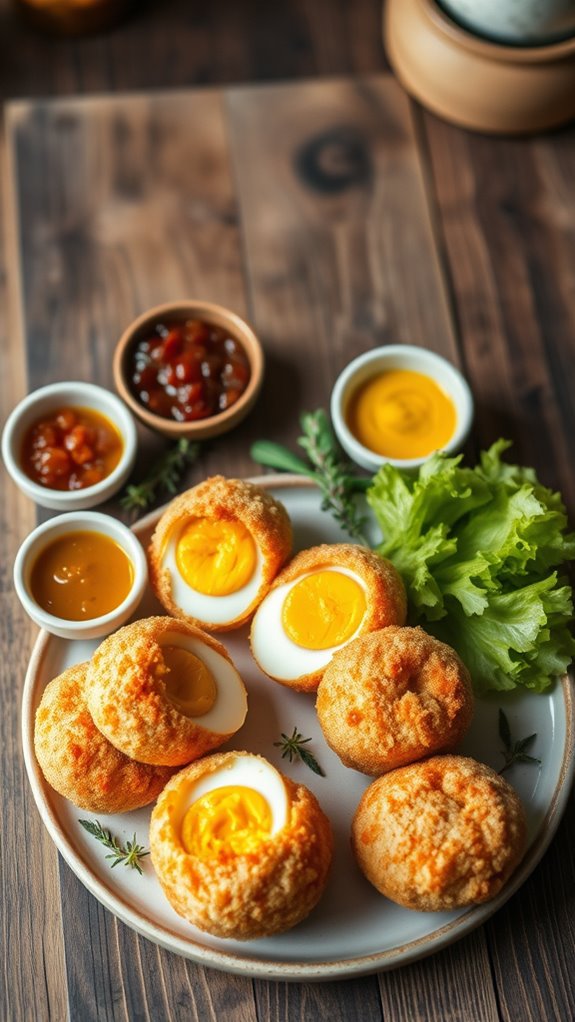When it comes to culinary delights, you might say the Scottish egg is a delightful parcel of joy. This traditional treat, with its harmonious blend of hard-boiled egg and seasoned sausage, has graced tables for over a century. Whether you enjoy it warm at a picnic or cold at a gathering, the tantalizing flavors are irresistible. But what makes this dish so enduring? Let's explore its rich history and how to recreate it at home.
History
Though the origins of the Scottish egg are debated, many believe it dates back to the 19th century when it first appeared in picnic menus across Scotland.
Several origin theories suggest that it evolved from traditional methods of preserving eggs or a clever way to make use of leftover meats.
You can see its cultural significance reflected in its enduring presence at gatherings, from pub menus to festive celebrations.
The Scottish egg embodies a rustic charm, uniting flavors of sausage and egg in a portable package.
As you bite into one, you taste history—a nod to resourcefulness and community that resonates through generations.
It's more than just food; it's a culinary symbol of Scottish heritage worth savoring.
Recipe

Scottish eggs are a traditional British dish that boasts a rich and savory flavor, perfect for any occasion. This delightful recipe features hard-boiled eggs wrapped in seasoned sausage meat, coated in breadcrumbs, and then deep-fried or baked to golden perfection. The combination of textures—from the creamy egg yolk to the crispy exterior—makes this dish a favorite for picnics, brunches, or even as a snack at home.
The origins of the Scotch egg are somewhat unclear, but one thing is for certain: it's a classic that can be enjoyed hot or cold. It's particularly popular in pubs, where it's often served alongside a side of chutney or mustard. With this recipe, you can recreate the pub experience right in your own kitchen and impress your family and friends.
Ingredients:
- 6 large eggs
- 1 lb sausage meat
- 1 cup breadcrumbs
- 1 cup all-purpose flour
- 1 tsp salt
- 1 tsp black pepper
- 1 tsp dried herbs (like thyme or sage)
- Vegetable oil (for frying)
To make Scottish eggs, begin by bringing a pot of water to a boil. Carefully add the eggs and boil for about 6-7 minutes for a slightly soft center, or 9-10 minutes for fully hard-boiled. Once cooked, transfer the eggs to an ice bath to halt the cooking process, then peel.
In a bowl, mix the sausage meat with salt, pepper, and herbs. Divide the sausage into six equal portions, flatten each portion, and wrap it around an egg. Roll each wrapped egg in flour, dip into beaten egg (if desired), and coat in breadcrumbs. Heat the vegetable oil in a deep pan and fry the eggs until golden brown. Allow them to drain on paper towels before serving.
When cooking Scottish eggs, be mindful of the oil temperature; it should be hot enough to sizzle when the eggs are added but not so hot that they burn. For a healthier alternative, you can bake the eggs at 400°F (200°C) for 20-25 minutes, flipping halfway through for an even crisp.
Exploring different flavors by adding spices to the sausage or trying out different coatings like panko breadcrumbs can also elevate the dish! Enjoy your homemade Scottish eggs while they're warm for the best flavor and texture.
Nutritional Guide
When enjoying your homemade Scottish eggs, it's important to contemplate their nutritional content. These delicious treats pack a punch regarding caloric content, typically ranging from 250 to 300 calories per egg, depending on the ingredients.
While this might seem high, remember you're also getting significant protein benefits. Each egg contains around 12-15 grams of protein, essential for muscle repair and overall health.
The combination of the egg and sausage provides a balanced meal that can keep you energized throughout the day. Plus, you'll find essential vitamins and minerals like B12 and zinc, adding to their nutritional appeal.
Final Thought
As you indulge in a homemade Scottish egg, you'll discover that it's not just a flavorful treat but a delightful blend of texture and nourishment. This traditional dish carries cultural significance, representing Scottish culinary heritage and skill.
Enjoy it warm, with a side of tangy mustard or homemade chutney for a satisfying contrast. For elevated flavors, consider serving it alongside a crisp salad or your favorite pickles.
Whether you're sharing at a family gathering or enjoying a cozy picnic, Scottish eggs captivate with their combination of hearty sausage, velvety egg, and crispy coating. Don't hesitate to experiment with spices and herbs to give your personal twist.
These simple yet satisfying bites will surely make a lasting impression.
